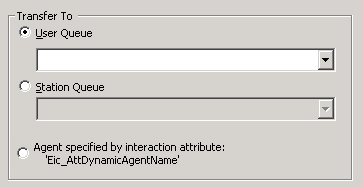- Contents
Interaction Attendant Help
 Transfer to an Agent
Transfer to an Agent
Agent Transfer sends a call to a specific user queue or station queue. This operation is commonly used to create a menu option that allows the caller to speak to an operator.
To transfer calls to a workgroup, use Group Transfer instead of Transfer to an Agent.
Node Characteristics frame
Options in this frame name the node, assign the digit used to select it, and establish whether or not it is active, used by default, logged, or tracked for reporting purposes.

Name field
The label you enter here becomes the name of the node in the tree structure.
Digit list box
Use this list to select the key that callers press to enter a caller data entry operation. When you assign a digit, the list displays only available digits—those that are not already in use at this level of the tree. If no digit is assigned, callers cannot invoke the operation directly. It is possible to create menu options that are invoked by a routing process, rather than by a user selection. For details, see invoke a menu operation automatically.
Active check box
By default, forms are "on", or "active", which means that Interaction Attendant will process them. If you uncheck a form's Active check box, the name of the node turns gray in the tree to indicate that the form is inactive. Interaction Attendant and its handlers will thereafter ignore the form and its children. Use this feature to save a configuration that you are testing. Inactive forms are invisible to callers. When a node is inactive, it appears grayed out in the tree view.
Default Action check box
At any given "level" in the tree structure, one node can be marked as the default action. The operation defined by the default node is performed if the caller does not press a key within the timeout period specified by that menu. The icon for default forms has a green border in the tree structure. Any node below a menu or schedule can be marked as the default action, by checking the form's default action check box.
Enable IVR Reporting
This option determines whether or not reporting data will be collected when control passes through this node. Several IVR Reports summarize this information. IVR Reporting is disabled by default. Enable it to capture the date, time and duration of time that the call remained in the node and its children. This option is hidden when Attendant is connected to a server that does not have reporting installed. For more information about this feature, see IVR Reporting Option.
Add entry to the Interaction Log
When this option is enabled, information about this node is appended to the call's Interaction Log when the call enters this node. This helps track the path that a call took through Attendant. The Interaction Log is maintained for reporting purposes. See View the Interaction Log for details.
Configure Speech Recognition... button
Select this button to configure words or phrases that can be associated with menu options. Callers can verbally indicate the options they want in the IVR instead of pressing a digit on the phone. You can enter multiple words and phrases for each menu item, just as callers may phrase the same request in different ways. For example, "transfer funds" or "funds transfer". See Add Speech Recognition keywords or phrases to Inbound Call Operations.
Transfer To frame
The options in this frame determine whether the call is transferred to a user or station queue. In general, you should specify a user queue when you need to route calls to a specific person, you should specify a station queue when you need to route calls to a specific telephone handset, and you should select the 'Eic_AttDynamicAgentName' interaction attribute when the user or station has been defined within the interaction attribute.
Note: The 'Eic_AttDynamicAgentName' interaction attribute is helpful for environments that contain a large number of users or stations and allows you to designate a single user or station to the attribute, thereby alleviating the task of searching through the queue lists. See Set Attribute for details.

User Queue radio button
This radio button enables the User Queue drop down list.
User Queue drop down list
This drop down list contains the names of user queues defined for the current server. The queue you select becomes the destination for the call.
Station Queue radio button
This radio button enables the Station Queue drop down list.
Station Queue drop down list
This drop down list contains the names of station queues defined for the current server. The queue you select becomes the destination for the call.
Agent specified by interaction attribute: radio button
This radio button specifies the transfer recipient as defined in the 'Eic_AttDynamicAgentName' interaction attribute. The user defined in this interaction attribute becomes the destination for the call.
Park Interaction check box
Select this check box to allow interactions to be parked on another person's extension for the agent to receive when he or she has an available status.




